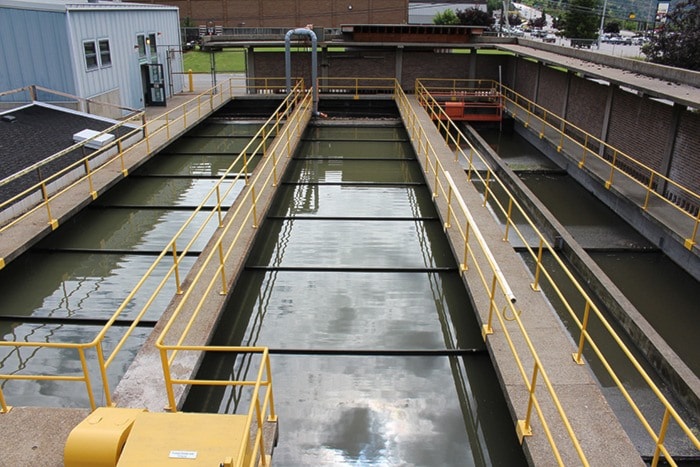The district’s liquid waste management facility could be getting an upgrade, so Rossland News went on site to see how Rossland’s sewage is currently disposed of and to find out what changes the upgrade may bring.
Moving forward with stage 2 of the Liquid Waste Management Plan (LWMP), the Regional District of Kootenay Boundary (RDKB) has received a recommendation from the plan’s advisory committee and steering committee to upgrade the existing Columbia Pollution Control Centre (CPCC), as opposed to building a new plant at a different site.
Currently the CPCC’s incoming effluent — as professionals in the biz refer to our sewage — makes its first stop in the headworks building — by far the worst smelling part of the CPCC — where non-organic solids and grit (sand and gravel) are removed. The amount of effluent flowing into the headworks building is 7600 m3 or 76,000 liters a day. In the event that the RDKB decides to move forward with upgrading the centre, there will be a new headworks building with new equipment.
From here the effluent goes onto the primary clarifiers where the organic compounds settle and are removed to the anaerobic digesters. Currently the total suspended solids (TSS) and biological oxygen demand (BOD) are reduced by 50 to 60 per cent during this process.
“[BOD is] essentially a measure of how much oxygen the microorganisms in the waste water will use once they hit the receiving environment,” explained Cody Taylor, level 2 waste water treatment operator. “So that is detrimental to fish populations if we release too much BOD.”
In June, the CPCC’s BOD removal was 66.04 per cent and TSS removal was 78.45 per cent. Once secondary treatment is introduced in the upgraded plant, both BOD and TSS should be reduced by approximately 90 per cent.
The CPCC’s current operating permit was last amended in 1978. As a result, the centre has been grandfathered in and the plant is currently allowed up to 100 mg per liter of each in its outgoing effluent, whereas current provincial requirements are 25 mg per liter or less to empty into a water body like the Columbia River. Once the plant is upgraded, the CPCC will have to meet current standards.
 To make sure the centre is meeting its requirements, staff frequently run in-house BOD, TSS and other tests on the effluent. Every hour samples are also automatically taken, and those are sent to CARO Analytical Services in Kelowna. The permit also only allows the CPCC to discharge up to 13,600 m3, but the CPCC sometimes exceeds that when flows are high.
To make sure the centre is meeting its requirements, staff frequently run in-house BOD, TSS and other tests on the effluent. Every hour samples are also automatically taken, and those are sent to CARO Analytical Services in Kelowna. The permit also only allows the CPCC to discharge up to 13,600 m3, but the CPCC sometimes exceeds that when flows are high.
“There’s really nothing we can do about it,” said Taylor. “We can’t really stop the waste water from coming into the plant.”
From the clarifiers, the solids go into the first anaerobic digester. Solids are continuously being added to the digester so the sludge is stirred, giving the anaerobic (non-oxygenated) bacteria in the digester access to all of the material.
“Essentially what we do — we take organic compounds from the organic sludge coming in, we convert that to organic acids, and then into methane [and] CO2 gas,” said Taylor. “So essentially in digesters you have two different types of bacteria: you have facultative, which are the acid-forming, so they take the organic compounds and convert them into organic acids; then you have the methane-forming bacteria, which convert the organic acids into methane [and] CO2 gas.”
The CO2 and methane are then used to run one of the boilers that heats the digesters. The sludge moves from the first digester into the second, where it is allowed to settle and thicken. This process will remain the same even if the CPCC is upgraded.
In the final solids step, the sludge is put through a belt filter press that removes all of the water. The resulting solid is sent to the landfill and the water is put back through the treatment process. If the plant is upgraded, the press will be replaced with a centrifuge, which basically spins really fast to throw the water off.
In the meantime, once the effluent has gone through primary treatment, it’s disinfected in the chlorine contact tank, but that will likely change in the event of an upgrade.
“At the moment, what’s been proposed is using UV to disinfect the effluent,” said Aline Bennett, assistant project engineer at Opus DaytonKnight Consultants, the company consulting on options for building a new plant or making upgrades.
Chlorine is then removed from the disinfected effluent, which is discharged into the Columbia.
